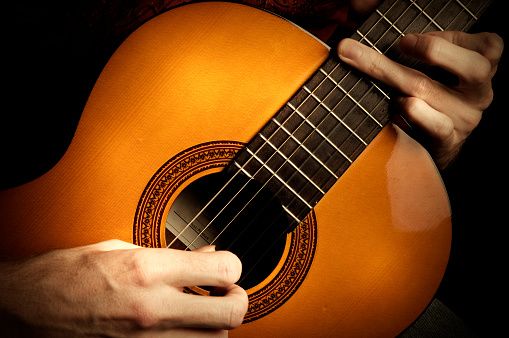Shape of Guitars
The shape of the Guitar From Prehistory Through the Middle Ages
The history of the guitar generally goes back to two instruments, the oud, and the lute, which predate written history. Many say that a man known as Lamech, who was Noah’s grandfather and the sixth grandson of Adam and Eve, designed the Arab precursor to the guitar. Lamech was inspired to design the shape of the instrument, known as an oud, after hanging the body of his dead son from a tree. The Moors brought the oud with them when they invaded Southern Spain in 711 AD.
Shape From the 15th Century to Present Day
The lute came in a variety of shapes and sizes but generally had a curved back. The instrument passed from the Egyptians to the Greeks and then onto the Romans, who took it to Europe. The first ancient pictorial record of a lute-like stringed instrument first appeared in 3500 to 3200 BCE in Southern Mesopotamia – Iraq, which is now Nasiriyah City. The image depicts a female crouching on a boat; the position of her hands on the instrument indicates she is playing an instrument.
Long- and short-necked varieties of lutes continued to appear in pictorial records throughout Mesopotamian and Egyptian history. Metropolitan Museums of New York, Philadelphia, Cleveland, and the British Museum display many examples of these pictorial records on clay tablets and papyrus paper.
The lute had evolved significantly by the end of the Renaissance – many lutes had up to 20 or 30 strings – but the lute-like shape of the instrument was fading in popularity. By the 15th and 16th centuries, musicians in Spain began to favor instruments featuring the familiar curved shape we now associate with guitars. These guitars, known as Baroque guitars, effectively replaced the lute as the goto-stringed instrument for musicians from about 1600 to 1750. Further refinements, such as five courses of gut strings and moveable frets, made these instruments easier to play.
The vihuela, which has incurving sides that give its body an hourglass shape, became popular in Spain, Portugal, and Italy during that time too. Mariachi groups still use a version of the vihuela today
The evolution of Spanish guitars settled by the 1790s; they had the standard body type and six courses of strings that resemble the modern guitar but were smaller. Spanish musician and guitar maker Antonio de Torres Jurado changed all that in the mid-1800s when he created the style of guitar that gave rise to all guitars to follow. Many people consider him “one of the single most important inventors in the history of the guitar.” His guitars featured a broadened body, thinned belly, and increased curve at the waist. He also replaced wooden tuning pegs with machined heads. His innovative approach to body design and fan bracing, which is a system of wooden struts inside the instrument, gave his classical guitars their distinctive, rich voice.
Influential Spanish guitarist Andres Segovia established Torres’ classic guitar as a concert instrument. The talented guitarist also penned complex musical compositions that we now identify as “classical guitar” music. At about this same time, Europeans brought a steel-stringed version of the Spanish instrument when they immigrated to America. There, the modern guitar took on a new shape and a new place in history, with the invention of the flat top, archtop, and modern electric guitar.

VLWnylXhg
VLWnylXhg
lPxpOZDEKXjgqoIi
Leave a reply
Celebrating the Vibrant Melodies of Holi: Songs Across India
2024-03-29 17:00:20
The Undeniable Significance of Song Lyrics
2024-01-17 18:11:41
The Profound Impact of Music on Today's Society
2024-01-03 16:03:40
Harmony in Frost: Exploring the Melodies of Winter
2023-12-21 20:06:31
Indian Ghazal: The Soulful Poetry of Emotions
2023-10-11 19:47:24
Lok Geeti: The Soulful Music of the People
2023-10-04 15:52:25